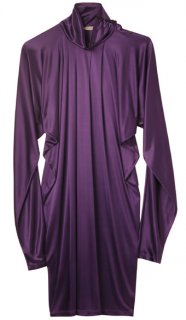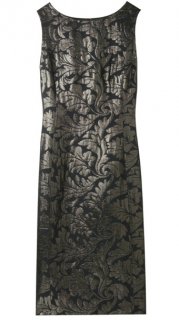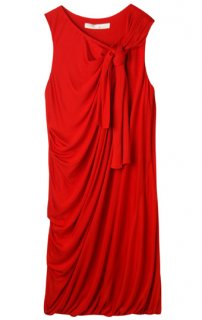November 29, 2007
The Pour-Me-Into-It Party Dress
By
ERIC WILSON
“IS that the shortest dress in the world?”
Oscar de la Renta asked teasingly of Bee Shaffer, the daughter of
Anna Wintour, as she navigated the crowd two weeks ago at 7th on Sale, the fashion industry’s closest approximation of a holiday ball.
Her dress, a strapless design in a plush red and gold floral print from Dolce & Gabbana, could hardly have been described as immodest. The shapely frock stopped a few inches above her knee. But what probably caught Mr. de la Renta’s eye was the refreshing sight, at the beginning of this holiday season, of a structured dress in a print that seemed almost decadent.
Mr. de la Renta himself had dressed the actress
Jennifer Connelly in a Jezebel-worthy crimson gown with a fitted basket-weave midriff, and
Kate Bosworth arrived in a short and sexy Proenza Schouler dress, a wrap shape in a shade of leathery cordovan.
Where were the little black dresses, those staples of holiday fare? What happened to last winter’s easygoing party frocks that replicated simple geometric shapes — the circular pouf, the triangular trapeze, the rectangular shift? Turns out they were all square.
“The baby-doll dress is dead,” Sarah Easley, an owner of Kirna Zabête, the directional SoHo store, said with no small degree of satisfaction. “The designer customer is looking for a little more tailoring.”
Lela Rose, the society designer, chimed in with a similar observation. “People want things that are a little more form-fitted,” she said. “I love the idea of the slimmed-down sack dress, which is something that allows you to eat and still show off your legs. You just don’t look like a tent.”
Nevertheless, designers and retailers have been feeling a little edgy about a holiday season that is unlikely to lend itself to celebratory excess. Customers, or at least those who are not in a position to demand their salaries be paid in euros, are looking at a lot of things as the holidays approach, like oil prices, their carbon footprints, their
iPhone bills.
And designers want how much for a dress?
Still, they know that last year’s blobby thigh-high party dresses need to be replaced with something. Wouldn’t you be embarrassed, the racks seem to whisper, to turn up in a pink pouf in the face of slimmed down Leger-esque shapes and strapless sheaths?
If this season’s party dresses are more fitted, they are not necessarily more conservative, nor a rerun of long evening gowns in velvet or flowing chiffon. Many customers at Kirna Zabête have been drawn to structured versions in bold colors or splashy prints from Thakoon, Derek Lam and
Narciso Rodriguez. Perhaps they were emboldened by the strong display of prints throughout next spring’s collections and want to get a jump on the season.
As Sue Stemp, a designer of a sprightly line of thigh-baring dresses in electric prints, said: “When dressing for this holiday season, I think ‘up the glamour’ with a chic little cocktail dress that incorporates an interesting print. Then, if you end up in the kitchen or on the dance floor, any spills will just blend into the pattern.”
At Phillip Lim’s store in SoHo, shoppers are more interested in metallic colors, as in a $620 gold strapless dress trimmed with orchid petals, and structured looks like Mr. Lim’s “ultimate tuxedo dress,” an elongated wool jacket that sells for $795. The model Irina Lazareanu wore one to the
Costume Institute gala this year.
Uptown at Peter Elliot, the 30-year-old retailer of upper-crust attire, there has even been a run on tailored blazers — short sequined ones from Tracy Reese for $405 and silk jacquard smoking jackets from Belvest for $2,300, said Eileen Sorota, the manager of the women’s store. Ms. Rose noted that the heavy luxury fabrics that are popular at the moment — like wool lace and graphically textured silk and wool blends — work better in structured garments.
Sari Sloane, the vice president for fashion merchandising at Intermix stores, said that the trend for fitted dresses has dovetailed this season with a taste among customers for glitzier metallics and sequined looks at various price points.
“Both looks are very different from last year,” she said. “It’s a welcome change for the consumer to be in a more sexy fitted dress that shows off your body and also looks modern.”
The look, Ms. Sloane noted, owes a big debt to the newly developed cult of Herve Leger, whose bandage dresses of the 1980s (think of Robert Palmer’s escorts) have been turning up, in new incarnations, on curvaceous celebrities like
Beyoncé and
Victoria Beckham. The skintight dresses, which sell for about $1,000, have been the hottest items at Intermix this fall, but similarly fitted dresses from
Robert Rodriguez for under $500 and bandage skirts from Privee for $225 have also been popular.
“They are fun and youthful looks, but what’s great is that they can be dressed up or dressed down,” Ms. Sloane said.
Such versatility, this holiday season, is a crucial component for fashion, no matter what the price.
“We are trying to open customers’ minds to the many possibilities of the humble party frock,” said Ms. Easley of Kirna Zabête. It may help, she suggests, for a customer to know that she can get some mileage from the dress beyond a night of company cocktails.
“A holiday dress used to be enough, but now it’s just a starting point because people are really layering their dressing,” she said. “The dress that goes to a holiday party on Thursday night might go to the office on Friday with a pair of leggings and Lanvin flat boots, or with a Balenciaga turtleneck under it.”
That must have been some party.












 ) and i see no need to purchase any more any time soon..
) and i see no need to purchase any more any time soon..












 an uncharacteristically grown-up look from Alice Temperley. I've always found Temperley's flower-child aesthetics to be a bit forced--long flowy dresses with patterns that resemble table linens or window drapery aren't exactly appropriate for the price she's charging. In terms of design, she relies almost too much on ethnic-inspired prints to make her point. But her restraint (relatively speaking) here is wonderful. The gold saves it from becoming an ordinary chiffon dress, and I was impressed by the fluidity, because this level of tailoring/construction is either rare for the designer or gets lost in the psychodelic prints she often favors. Leave the pretend-hippie look to Jenni Kayne, please.
an uncharacteristically grown-up look from Alice Temperley. I've always found Temperley's flower-child aesthetics to be a bit forced--long flowy dresses with patterns that resemble table linens or window drapery aren't exactly appropriate for the price she's charging. In terms of design, she relies almost too much on ethnic-inspired prints to make her point. But her restraint (relatively speaking) here is wonderful. The gold saves it from becoming an ordinary chiffon dress, and I was impressed by the fluidity, because this level of tailoring/construction is either rare for the designer or gets lost in the psychodelic prints she often favors. Leave the pretend-hippie look to Jenni Kayne, please. 







